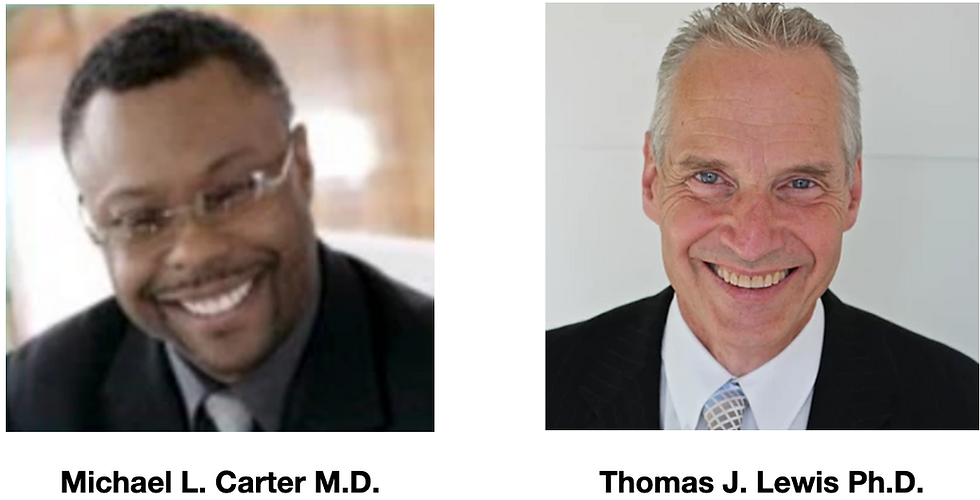Silicon Valley Health Alliance
- Dr. Thomas J. Lewis

- Feb 12, 2021
- 4 min read
I was asked to present our program to the Silicon Valley Health Alliance a couple of months ago. In this LONG video, I explain the rationale behind the interpretation of lab values from a CHRONIC perspective. The standard of care lab "reference ranges" are a very poor indicator of you true health status. In the traditional system, they are looking to determine if you are very ill or at VERY high risk of an impending adverse event.... Nobody really wants to be in that state of poor health.
Do you think someone who just had a heart attack was perfectly healthy the day before? In many cases, I can assert that their standard lab values like lipids and A1C were "normal." It's reasonable to believe that someone who just had a heart attack was on the path to this event for many years, even decades. There is ample evidence in the literature to corroborate this. And, many lab values, when interpreted from a chronic perspective could have anticipated the event with reasonable statistical accuracy. MORE importantly, the right lab values, and interpretation thereof, often provide information to prevent such events.
In the standard of care, the "normal" limits are intended to measure a "fire" in your body. We look to determine if you have a "smoldering" condition that may lead to that fire.
Here is the link to my Silicon Valley talk.... Yup it's long - so consider watching the beginning as I explain reference interval values vs our SCIENTIFIC normal lab values.
Here are a couple examples:
EXAMPLE 1: White blood cells are your primary defense against disease, mainly caused by infection. In the standard of care, the "reference range" for normal is a WBC count of 3,400 - 10,800. However, a very large and comprehensive study by Harvard Medical School shows that people who have a WBC of 6,700 are twice as likely to DIE of a heart attack compared to people with the WBC of 4,700, over a 6-year period. Clearly there is something terribly wrong with the standard of care reference values.

EXAMPLE 2: H-Pylori is a pathogen that is literally a living antacid. It can infiltrate your gut and reduce the level of acid in your stomach leading to malabsorption of minerals, among other things. So many adverse conditions stem from malabsorption which is fundamental to the simple, yet elegant process, of repair and recovery.
The discovery of h-pylori as a cause of stomach ulcers lead to the Nobel Prize award in 2005. However, it took drastic measures by the 2 pathologist who discovered this cause/effect relationship. One of the Nobel Prize recipients, Dr. Barry Marshall, infected himself with h-pylori to demonstrate that ulcers came from this bug. Regardless of this act and the Nobel Prize, I have worked with many people who have or had h-pylori but their doctors ignored it. On our "testimonials" page, we highlight a case of a gentleman who developed colon cancer and had surgery and chemo. When we reviewed his chart, we found he was positive for h-pylori 5 years prior to the cancer diagnosis, but it was never treated. Years later, when he joined our program, we re-tested for h-pylori, for which he was still positive, and then treated him. Ever wonder why cancer strikes back?
You might enjoy this article by Paul Thagard of Waterloo University who explains the stumbling blocks to innovation, using the h-pylori case study as an example.
Clinical delivery of medicine is one of the least progressive industries in the world. There are many reasons behind this and the most prominent one is financial. After all, a "cured" patient is a lost customer. I encourage you to read this article by Clayton Christensen, the author of "The Innovators Dilemma."
Here is an excerpt from my book, "Quarterback Your Own Health" on the subject of h pylori. Note that traditional doctors initially (and in some cases still) thought Warren and Marshall were "mad."
Ulcers: Drs. Warren and Marshall, pathologists from Australia, made a revolutionary discovery during a routine diagnosis of diseased tissue. Through his advanced diagnosis—driven by his personal curiosity—he was able to prove a cause-effect relationship that has profoundly impacted treatments of stomach ulcers. Warren, along with his colleague, Dr. Marshall, hypothesized that a specific bacteria known today as H-Pylori causes stomach ulcers. At that time (and inexplicably still by some medical professionals today) the belief was that these ulcers were caused mainly by stress and excess stomach acid. Marshall and Warren's suggestion that ulcers may be caused by bacteria was initially viewed by some researchers as absurd and outrageous. Martin Blaser of the Division of Infectious Diseases at the Vanderbilt University School of Medicine thought a 1983 talk by Marshall was "the most preposterous thing I'd ever heard; I thought, this guy is a madman." [i] In fact, these two Australians, Warren and Marshall, were not even invited to present their data at gastroenterology society meetings for many years. Blaser has since become one of the leading researchers on Helicobacter pylori, having changed his belief in the face of overwhelming evidence. Warren and Marshall won the Nobel Prize for Medicine in 2005.
[i] Thomas, G. (2007). Education and theory: Strangers in paradigms. McGraw-Hill Education (UK).
Look below to find the times and links to our weekly webinars....
What is the Chronic Disease Support program?
1. It is a weekly live, interactive, 1h, webinar on Zoom covering important health-related topics.
2. The schedule is Mondays at 12 noon EST and Tuesday at 8 pm EST. The topic is the same at both times/dates. We offer 2 times per week to accommodate schedules.
Monday Zoom link (noon EST):
Tuesday Zoom link (8pm EST):
copy and paste to your browser at the designed time to join.
Archived videos are found at https://www.youtube.com/channel/UCd_LYVg22017AkE1GfKa4_A

Stay Well






Comments